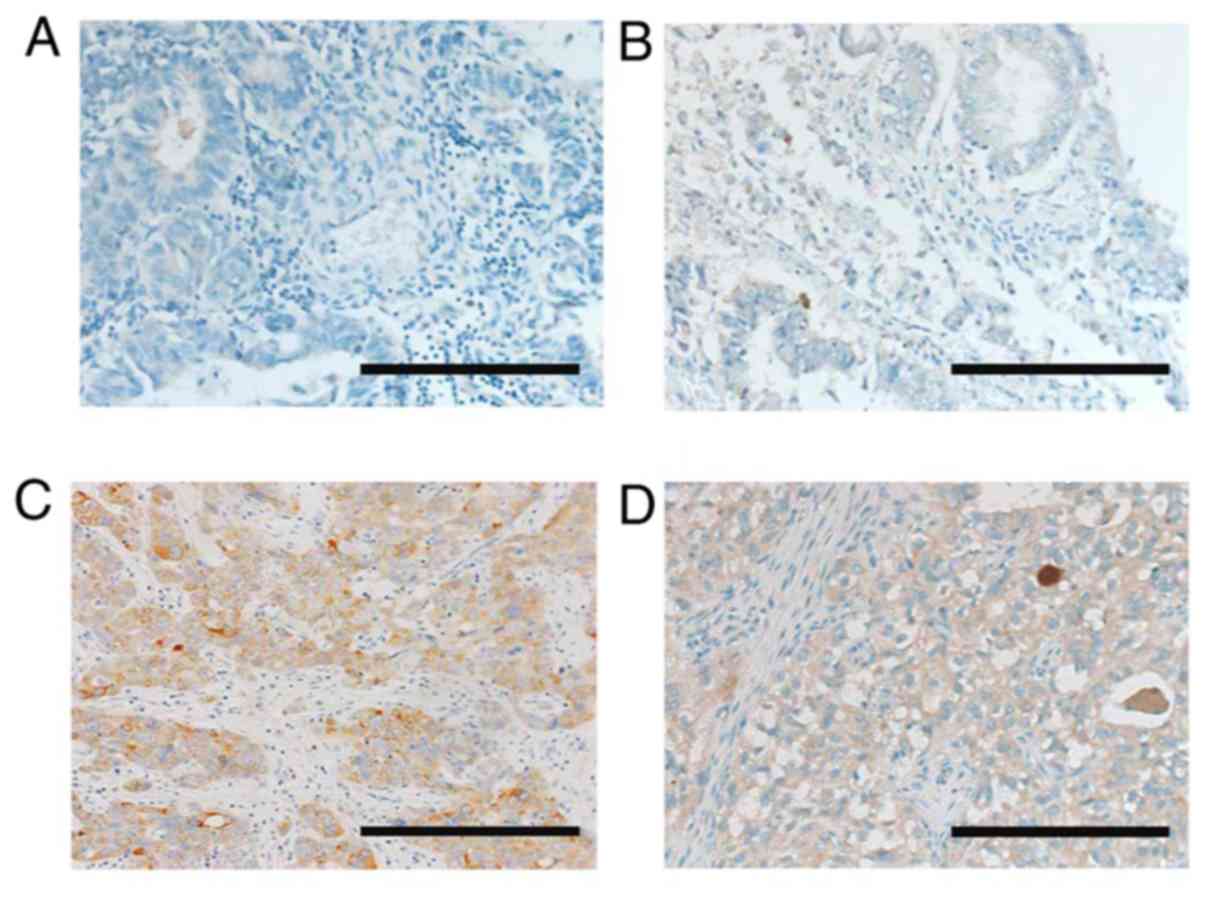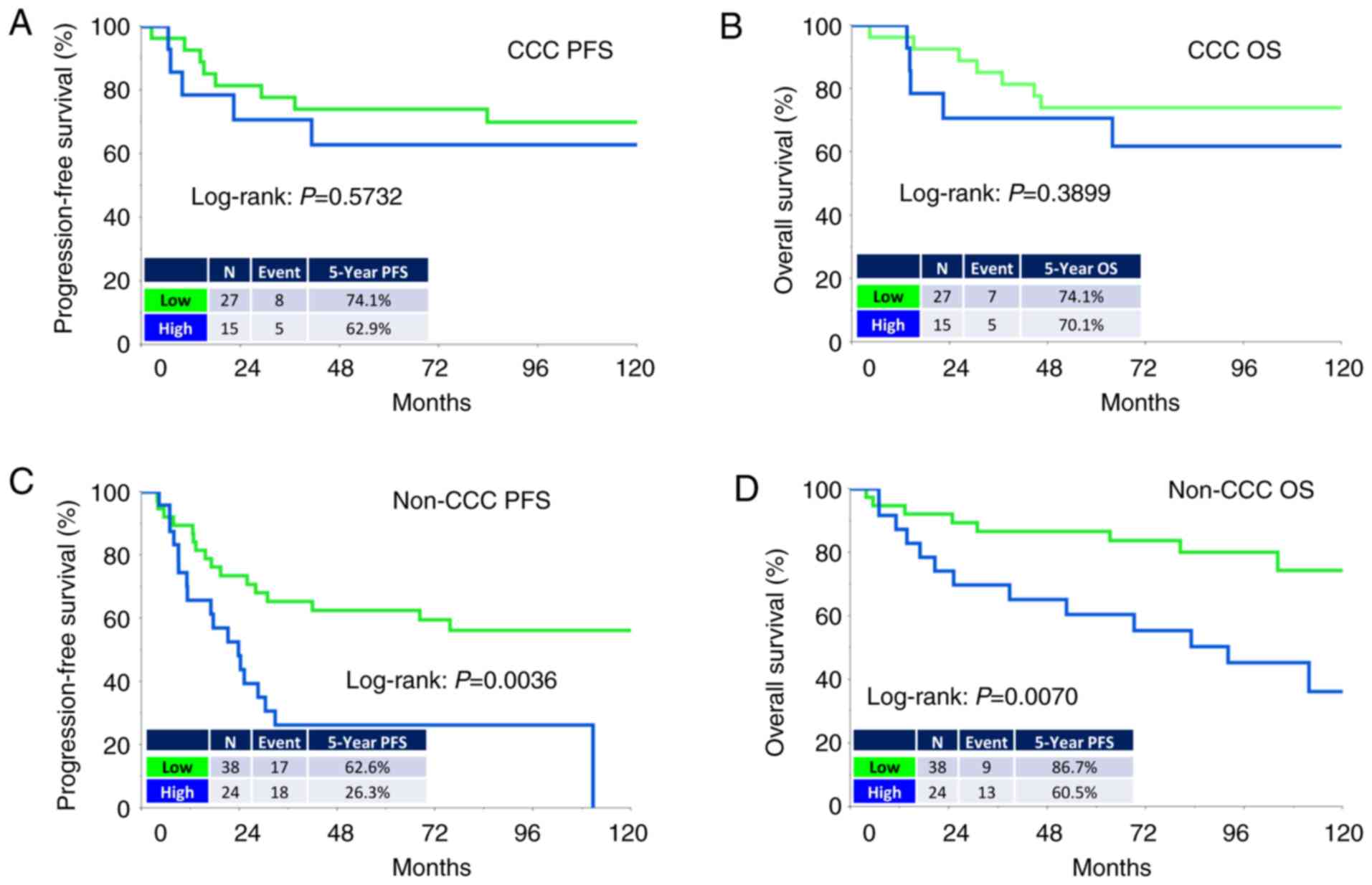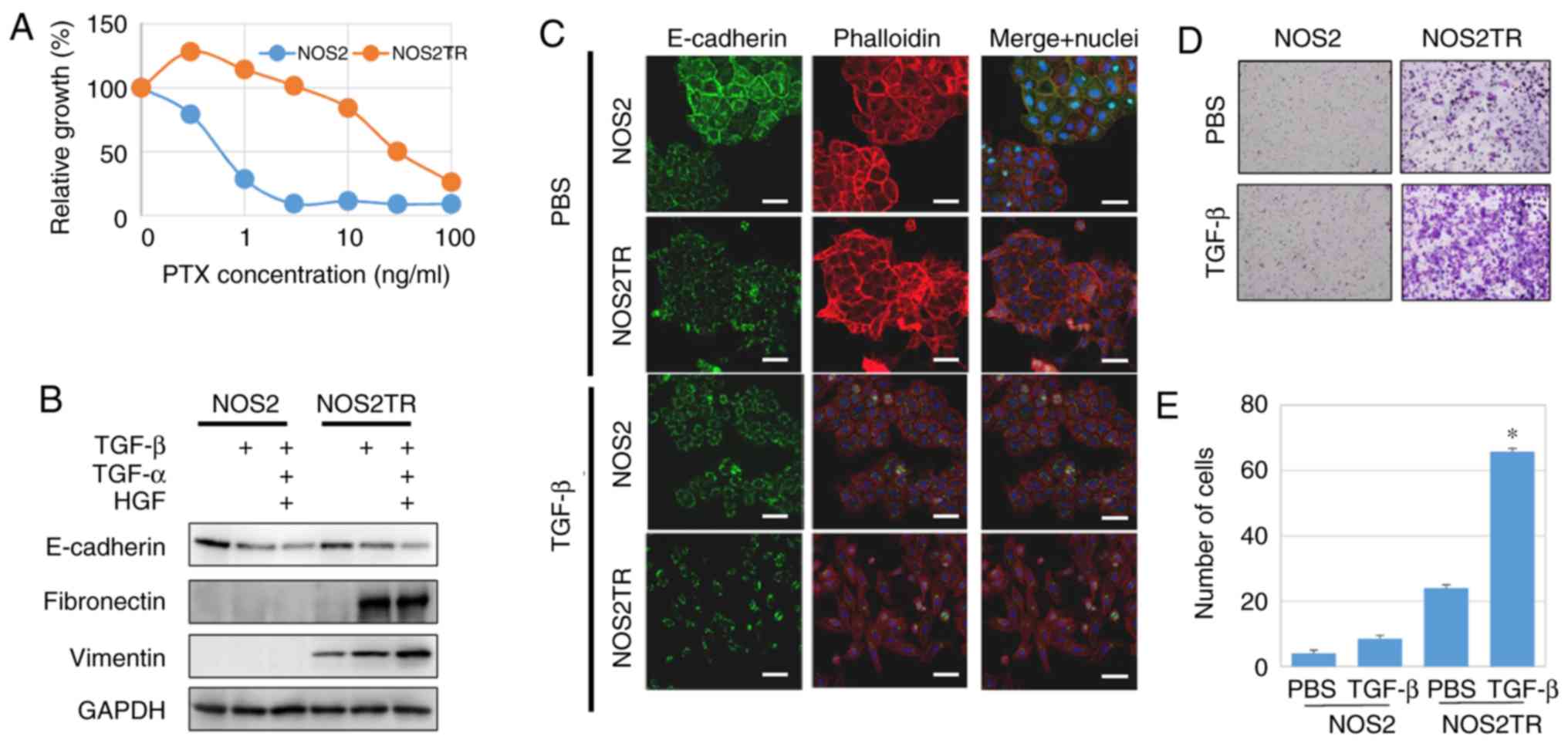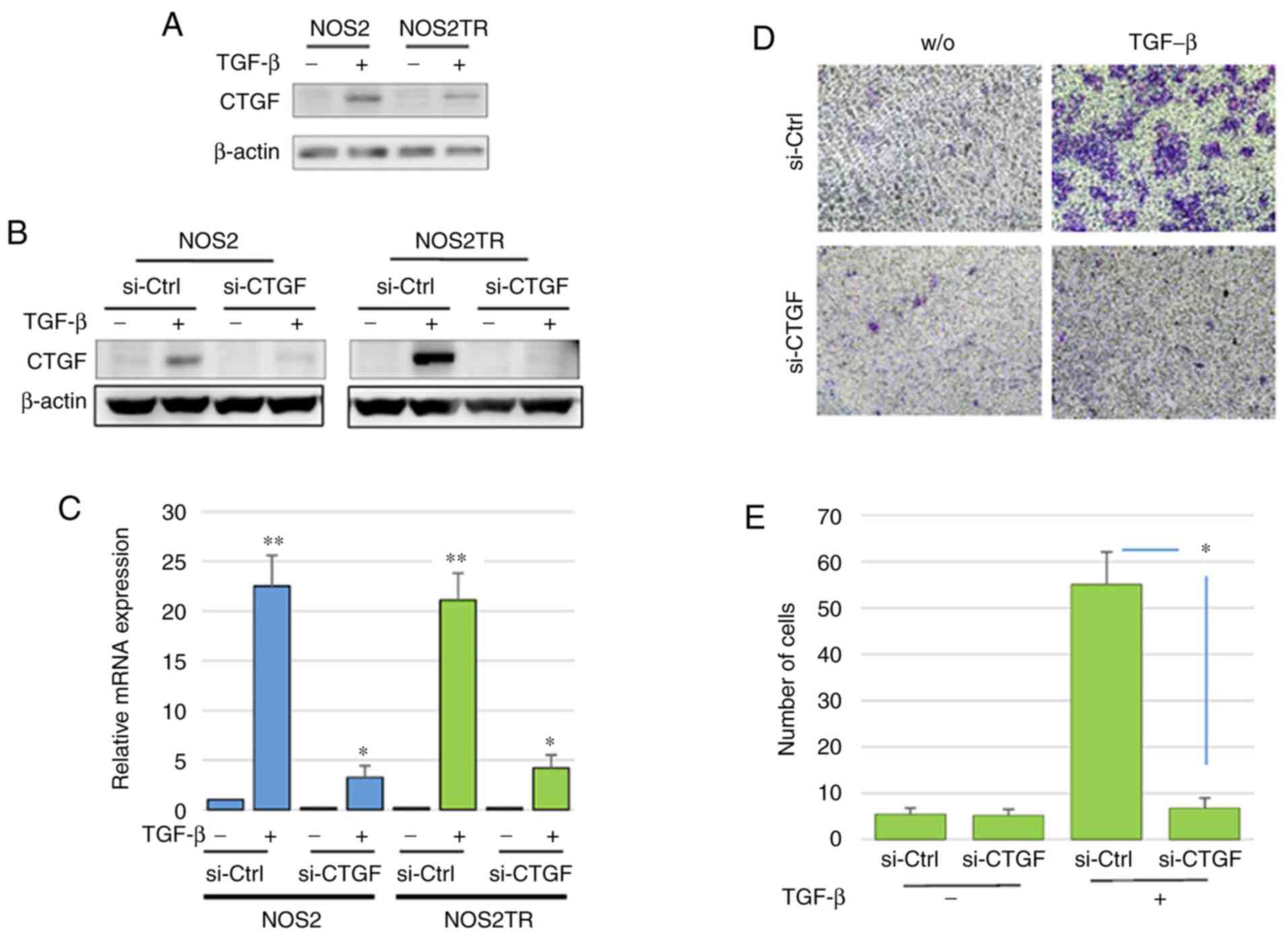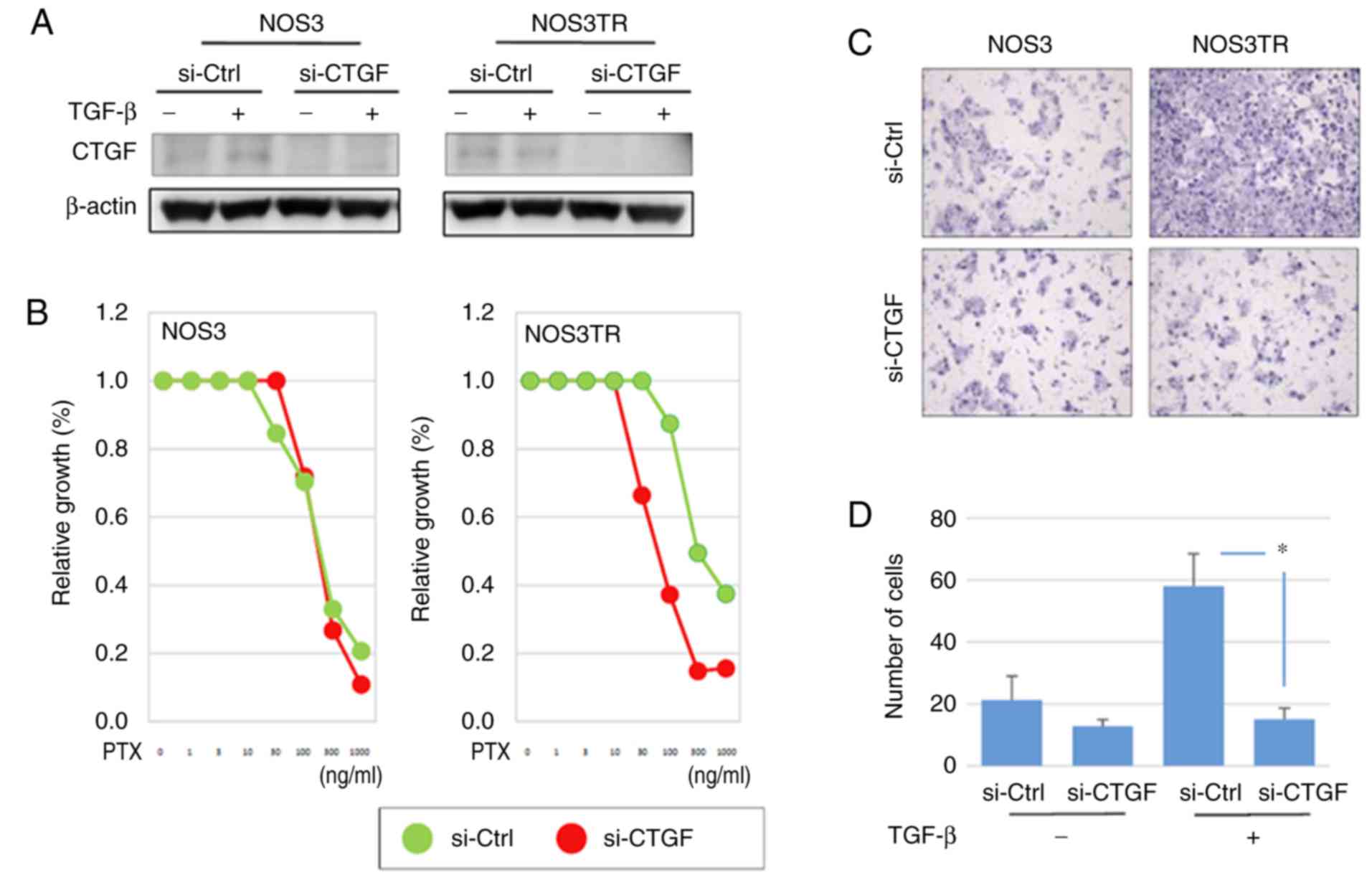|
1
|
Bray F, Ferlay J, Soerjomataram I, Siegel
RL, Torre LA and Jemal A: Global cancer statistics 2018: GLOBOCAN
estimates of incidence and mortality worldwide for 36 cancers in
185 countries. CA Cancer J Clin. 68:394–424. 2018. View Article : Google Scholar : PubMed/NCBI
|
|
2
|
Brun JL, Feyler A, Chene G, Saurel J, Brun
G and Hocke C: Long-term results and prognostic factors in patients
with epithelial ovarian cancer. Gynecol Oncol. 78:21–27. 2000.
View Article : Google Scholar : PubMed/NCBI
|
|
3
|
Thiery JP: Epithelial-mesenchymal
transitions in tumour progression. Nat Rev Cancer. 2:442–454. 2002.
View Article : Google Scholar : PubMed/NCBI
|
|
4
|
Boyer B, Valles AM and Edme N: Induction
and regulation of epithelial-mesenchymal transitions. Biochem
Pharmacol. 60:1091–1099. 2000. View Article : Google Scholar : PubMed/NCBI
|
|
5
|
Vernon AE and LaBonne C: Tumor metastasis:
A new twist on epithelial-mesenchymal transitions. Curr Biol.
14:R719–R721. 2004. View Article : Google Scholar : PubMed/NCBI
|
|
6
|
Eisenkop SM, Friedman RL and Wang HJ:
Complete cytoreductive surgery is feasible and maximizes survival
in patients with advanced epithelial ovarian cancer: A prospective
study. Gynecol Oncol. 69:103–108. 1998. View Article : Google Scholar : PubMed/NCBI
|
|
7
|
Kajiyama H, Mizuno M, Shibata K, Kawai M,
Nagasaka T and Kikkawa F: Extremely poor postrecurrence oncological
outcome for patients with recurrent mucinous ovarian cancer. Int J
Clin Oncol. 19:121–126. 2014. View Article : Google Scholar : PubMed/NCBI
|
|
8
|
Kajiyama H, Shibata K, Mizuno M, Umezu T,
Suzuki S, Yamamoto E, Fujiwara S, Kawai M, Nagasaka T and Kikkawa
F: Long-term clinical outcome of patients with recurrent epithelial
ovarian carcinoma: Is it the same for each histological type? Int J
Gynecol Cancer. 22:394–399. 2012. View Article : Google Scholar : PubMed/NCBI
|
|
9
|
Brigstock DR, Goldschmeding R, Katsube KI,
Lam SC, Lau LF, Lyons K, Naus C, Perbal B, Riser B, Takigawa M and
Yeger H: Proposal for a unified CCN nomenclature. Mol Pathol.
56:127–128. 2003. View Article : Google Scholar : PubMed/NCBI
|
|
10
|
Brigstock DR: The connective tissue growth
factor/cysteine-rich 61/nephroblastoma overexpressed (CCN) family.
Endocr Rev. 20:189–206. 1999. View Article : Google Scholar : PubMed/NCBI
|
|
11
|
Leask A and Abraham DJ: All in the CCN
family: Essential matricellular signaling modulators emerge from
the bunker. J Cell Sci. 119:4803–4810. 2006. View Article : Google Scholar : PubMed/NCBI
|
|
12
|
Tsai HC, Su HL, Huang CY, Fong YC, Hsu CJ
and Tang CH: CTGF increases matrix metalloproteinases expression
and subsequently promotes tumor metastasis in human osteosarcoma
through down-regulating miR-519d. Oncotarget. 5:3800–3812. 2014.
View Article : Google Scholar : PubMed/NCBI
|
|
13
|
Han Q, Zhang HY, Zhong BL, Wang XJ, Zhang
B and Chen H: MicroRNA-145 inhibits cell migration and invasion and
regulates epithelial-mesenchymal transition (EMT) by targeting
connective tissue growth factor (CTGF) in esophageal squamous cell
carcinoma. Med Sci Monit. 22:3925–3934. 2016. View Article : Google Scholar : PubMed/NCBI
|
|
14
|
Lai D, Ho KC, Hao Y and Yang X: Taxol
resistance in breast cancer cells is mediated by the hippo pathway
component TAZ and its downstream transcriptional targets Cyr61 and
CTGF. Cancer Res. 71:2728–2738. 2011. View Article : Google Scholar : PubMed/NCBI
|
|
15
|
Yang K, Gao K, Hu G, Wen Y, Lin C and Li
X: CTGF enhances resistance to 5-FU-mediating cell apoptosis
through FAK/MEK/ERK signal pathway in colorectal cancer. Onco
Targets Ther. 9:7285–7295. 2016. View Article : Google Scholar : PubMed/NCBI
|
|
16
|
Tsai HC, Huang CY, Su HL and Tang CH: CCN2
enhances resistance to cisplatin-mediating cell apoptosis in human
osteosarcoma. PLoS One. 9:e901592014. View Article : Google Scholar : PubMed/NCBI
|
|
17
|
Wang L, He J, Xu H, Xu L and Li N: MiR-143
targets CTGF and exerts tumor-suppressing functions in epithelial
ovarian cancer. Am J Transl Res. 8:2716–2726. 2016.PubMed/NCBI
|
|
18
|
Kajiyama H, Kikkawa F, Suzuki T, Shibata
K, Ino K and Mizutani S: Prolonged survival and decreased invasive
activity attributable to dipeptidyl peptidase IV overexpression in
ovarian carcinoma. Cancer Res. 62:2753–2757. 2002.PubMed/NCBI
|
|
19
|
Kajiyama H, Shibata K, Ino K, Mizutani S,
Nawa A and Kikkawa F: The expression of dipeptidyl peptidase IV
(DPPIV/CD26) is associated with enhanced chemosensitivity to
paclitaxel in epithelial ovarian carcinoma cells. Cancer Sci.
101:347–354. 2010. View Article : Google Scholar : PubMed/NCBI
|
|
20
|
Kajiyama H, Shibata K, Terauchi M,
Yamashita M, Ino K, Nawa A and Kikkawa F: Chemoresistance to
paclitaxel induces epithelial-mesenchymal transition and enhances
metastatic potential for epithelial ovarian carcinoma cells. Int J
Oncol. 31:277–283. 2007.PubMed/NCBI
|
|
21
|
Maeda O, Shibata K, Hosono S, Fujiwara S,
Kajiyama H, Ino K, Nawa A, Tamakoshi K and Kikkawa F: Spectrin αII
and βII tetramers contribute to platinum anticancer drug resistance
in ovarian serous adenocarcinoma. Int J Cancer. 130:113–121. 2012.
View Article : Google Scholar : PubMed/NCBI
|
|
22
|
Utsumi F, Kajiyama H, Nakamura K, Tanaka
H, Mizuno M, Ishikawa K, Kondo H, Kano H, Hori M and Kikkawa F:
Effect of indirect nonequilibrium atmospheric pressure plasma on
anti-proliferative activity against chronic chemo-resistant ovarian
cancer cells in vitro and in vivo. PLoS One. 8:e815762013.
View Article : Google Scholar : PubMed/NCBI
|
|
23
|
Sakata J, Utsumi F, Suzuki S, Niimi K,
Yamamoto E, Shibata K, Senga T, Kikkawa F and Kajiyama H:
Inhibition of ZEB1 leads to inversion of metastatic characteristics
and restoration of paclitaxel sensitivity of chronic chemoresistant
ovarian carcinoma cells. Oncotarget. 8:99482–99494. 2017.
View Article : Google Scholar : PubMed/NCBI
|
|
24
|
Hosono S, Kajiyama H, Terauchi M, Shibata
K, Ino K, Nawa A and Kikkawa F: Expression of Twist increases the
risk for recurrence and for poor survival in epithelial ovarian
carcinoma patients. Br J Cancer. 96:314–320. 2007. View Article : Google Scholar : PubMed/NCBI
|
|
25
|
Livak KJ and Schmittgen TD: Analysis of
relative gene expression data using real-time quantitative PCR and
the 2(-Delta Delta C(T)) method. Methods. 25:402–408. 2001.
View Article : Google Scholar : PubMed/NCBI
|
|
26
|
Sugiyama K, Kajiyama H, Shibata K, Yuan H,
Kikkawa F and Senga T: Expression of the miR200 family of microRNAs
in mesothelial cells suppresses the dissemination of ovarian cancer
cells. Mol Cancer Ther. 13:2081–2091. 2014. View Article : Google Scholar : PubMed/NCBI
|
|
27
|
Kurman RJ, Carcangiu ML, Herrington CS and
Young RH: WHO Classification of Tumours of Female Reproductive
OrgansFourth. IARC Press; 2014
|
|
28
|
Zeppernick F and Meinhold-Heerlein I: The
new FIGO staging system for ovarian, fallopian tube, and primary
peritoneal cancer. Arch Gynecol Obstet. 290:839–842. 2014.
View Article : Google Scholar : PubMed/NCBI
|
|
29
|
Chen VW, Ruiz B, Killeen JL, Coté TR, Wu
XC and Correa CN: Pathology and classification of ovarian tumors.
Cancer 97 (10 Suppl). S2631–S2642. 2003. View Article : Google Scholar
|
|
30
|
Sakata J, Kajiyama H, Suzuki S, Utsumi F,
Niimi K, Sekiya R, Shibata K, Senga T and Kikkawa F: Impact of
positive ZEB1 expression in patients with epithelial ovarian
carcinoma as an oncologic outcome-predicting indicator. Oncol Lett.
14:4287–4293. 2017. View Article : Google Scholar : PubMed/NCBI
|
|
31
|
Lau TS, Chan LK, Wong EC, Hui CW, Sneddon
K, Cheung TH, Yim SF, Lee JH, Yeung CS, Chung TK and Kwong J: A
loop of cancer-stroma-cancer interaction promotes peritoneal
metastasis of ovarian cancer via TNFα-TGFα-EGFR. Oncogene.
36:3576–3587. 2017. View Article : Google Scholar : PubMed/NCBI
|
|
32
|
Nakamura M, Ono YJ, Kanemura M, Tanaka T,
Hayashi M, Terai Y and Ohmichi M: Hepatocyte growth factor secreted
by ovarian cancer cells stimulates peritoneal implantation via the
mesothelial-mesenchymal transition of the peritoneum. Gynecol
Oncol. 139:345–354. 2015. View Article : Google Scholar : PubMed/NCBI
|
|
33
|
Wei W, Kong B, Yang Q and Qu X: Hepatocyte
growth factor enhances ovarian cancer cell invasion through
downregulation of thrombospondin-1. Cancer Biol Ther. 9:79–87.
2010. View Article : Google Scholar : PubMed/NCBI
|
|
34
|
Alvarez H, Corvalan A, Roa JC, Argani P,
Murillo F, Edwards J, Beaty R, Feldmann G, Hong SM, Mullendore M,
et al: Serial analysis of gene expression identifies connective
tissue growth factor expression as a prognostic biomarker in
gallbladder cancer. Clin Cancer Res. 14:2631–2638. 2008. View Article : Google Scholar : PubMed/NCBI
|
|
35
|
Bennewith KL, Huang X, Ham CM, Graves EE,
Erler JT, Kambham N, Feazell J, Yang GP, Koong A and Giaccia AJ:
The role of tumor cell-derived connective tissue growth factor
(CTGF/CCN2) in pancreatic tumor growth. Cancer Res. 69:775–784.
2009. View Article : Google Scholar : PubMed/NCBI
|
|
36
|
Boag JM, Beesley AH, Firth MJ, Freitas JR,
Ford J, Brigstock DR, de Klerk NH and Kees UR: High expression of
connective tissue growth factor in pre-B acute lymphoblastic
leukaemia. Br J Haematol. 138:740–748. 2007. View Article : Google Scholar : PubMed/NCBI
|
|
37
|
Li LY, Li EM, Wu ZY, Huang X, Shen JH, Xu
XE, Wu JY, Huang Q and Xu LY: Connective tissue growth factor
expression in precancerous lesions of human esophageal epithelium
and prognostic significance in esophageal squamous cell carcinoma.
Dis Esophagus. 24:337–345. 2011. View Article : Google Scholar : PubMed/NCBI
|
|
38
|
Wang MY, Chen PS, Prakash E, Hsu HC, Huang
HY, Lin MT, Chang KJ and Kuo ML: Connective tissue growth factor
confers drug resistance in breast cancer through concomitant
up-regulation of Bcl-xL and cIAP1. Cancer Res. 69:3482–3491. 2009.
View Article : Google Scholar : PubMed/NCBI
|
|
39
|
Mao Z, Ma X, Rong Y, Cui L, Wang X, Wu W,
Zhang J and Jin D: Connective tissue growth factor enhances the
migration of gastric cancer through downregulation of E-cadherin
via the NF-kB pathway. Cancer Sci. 102:104–110. 2011. View Article : Google Scholar : PubMed/NCBI
|
|
40
|
Sugiyama T, Kamura T, Kigawa J, Terakawa
N, Kikuchi Y, Kita T, Suzuki M, Sato I and Taguchi K: Clinical
characteristics of clear cell carcinoma of the ovary: A distinct
histologic type with poor prognosis and resistance to
platinum-based chemotherapy. Cancer. 88:2584–2589. 2000. View Article : Google Scholar : PubMed/NCBI
|
|
41
|
Shimada M, Kigawa J, Ohishi Y, Yasuda M,
Suzuki M, Hiura M, Nishimura R, Tabata T, Sugiyama T and Kaku T:
Clinicopathological characteristics of mucinous adenocarcinoma of
the ovary. Gynecol Oncol. 113:331–334. 2009. View Article : Google Scholar : PubMed/NCBI
|
|
42
|
Tsai HC, Huang CY, Su HL and Tang CH: CTGF
increases drug resistance to paclitaxel by upregulating survivin
expression in human osteosarcoma cells. Biochim Biophys Acta.
1843:846–854. 2014. View Article : Google Scholar : PubMed/NCBI
|
|
43
|
Edwards LA, Woolard K, Son MJ, Li A, Lee
J, Ene C, Mantey SA, Maric D, Song H, Belova G, et al: Effect of
brain- and tumor-derived connective tissue growth factor on glioma
invasion. J Natl Cancer Inst. 103:1162–1178. 2011. View Article : Google Scholar : PubMed/NCBI
|
|
44
|
Eguchi D, Ikenaga N, Ohuchida K, Kozono S,
Cui L, Fujiwara K, Fujino M, Ohtsuka T, Mizumoto K and Tanaka M:
Hypoxia enhances the interaction between pancreatic stellate cells
and cancer cells via increased secretion of connective tissue
growth factor. J Surg Res. 181:225–233. 2013. View Article : Google Scholar : PubMed/NCBI
|
|
45
|
Yang F, Tuxhorn JA, Ressler SJ, McAlhany
SJ, Dang TD and Rowley DR: Stromal expression of connective tissue
growth factor promotes angiogenesis and prostate cancer
tumorigenesis. Cancer Res. 65:8887–8895. 2005. View Article : Google Scholar : PubMed/NCBI
|
|
46
|
Kim HC, Ji W, Kim MY, Colby TV, Jang SJ,
Lee CK, Han SB and Kim DS: Interstitial pneumonia related to
undifferentiated connective tissue disease: Pathologic pattern and
prognosis. Chest. 147:165–172. 2015. View Article : Google Scholar : PubMed/NCBI
|
|
47
|
Tothill RW, Tinker AV, George J, Brown R,
Fox SB, Lade S, Johnson DS, Trivett MK, Etemadmoghadam D, Locandro
B, et al: Novel molecular subtypes of serous and endometrioid
ovarian cancer linked to clinical outcome. Clin Cancer Res.
14:5198–5208. 2008. View Article : Google Scholar : PubMed/NCBI
|
|
48
|
Crosas-Molist E, Bertran E and Fabregat I:
Cross-Talk Between TGF-β and NADPH oxidases during liver fibrosis
and hepatocarcinogenesis. Curr Pharm Des. 21:5964–5976. 2015.
View Article : Google Scholar : PubMed/NCBI
|
|
49
|
Dhanasekaran R, Nakamura I, Hu C, Chen G,
Oseini AM, Seven ES, Miamen AG, Moser CD, Zhou W, van Kuppevelt TH,
et al: Activation of the transforming growth factor-β/SMAD
transcriptional pathway underlies a novel tumor-promoting role of
sulfatase 1 in hepatocellular carcinoma. Hepatology. 61:1269–1283.
2015. View Article : Google Scholar : PubMed/NCBI
|
|
50
|
Liu J, Chen S, Wang W, Ning BF, Chen F,
Shen W, Ding J, Chen W, Xie WF and Zhang X: Cancer-associated
fibroblasts promote hepatocellular carcinoma metastasis through
chemokine-activated hedgehog and TGF-β pathways. Cancer Lett.
379:49–59. 2016. View Article : Google Scholar : PubMed/NCBI
|
|
51
|
Kroening S, Solomovitch S, Sachs M,
Wullich B and Goppelt-Struebe M: Regulation of connective tissue
growth factor (CTGF) by hepatocyte growth factor in human tubular
epithelial cells. Nephrol Dial Transplant. 24:755–762. 2009.
View Article : Google Scholar : PubMed/NCBI
|
|
52
|
Tsai CC, Wu SB, Kau HC and Wei YH:
Essential role of connective tissue growth factor (CTGF) in
transforming growth factor-β1 (TGF-β1)-induced myofibroblast
transdifferentiation from Graves' orbital fibroblasts. Sci Rep.
8:72762018. View Article : Google Scholar : PubMed/NCBI
|















